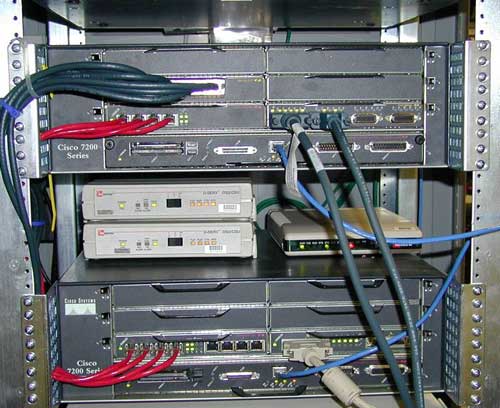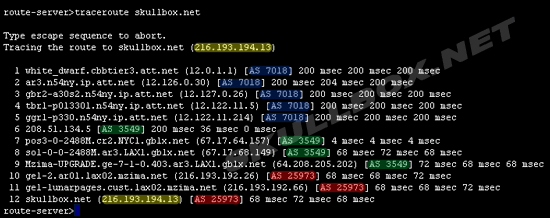
|

|

|

|

|

|

|

|

|

|

|

|

|

|

|

|

|

|

|

|

|

|

|

|

|

|

|

|

|

|
 |
|
|
|
|
Mailing List
|
|
By Joining the mailing list you will be notified of site updates.
|
|
Show Your Support For
This Site By Donating:
|
|
|
|
|


|
|
|
|
|
|

Using Route Servers
By Erik Rodriguez
Tags: route servers, AT&T route server, Cisco route servers, Cisco 7200 VXR, Internet routing table, DNS updates using route servers
This article describes the function of route servers. Route servers are open to any user on the Internet and are a valuable resource to find information about routing and traffic performance.
Route servers are setup by ISP's and backbone carriers to display information about networks running the BGP protocol. The term 'autonomous system' is used in this article. Autonomous systems (abbreviated AS) are nothing more than a network or group of networks under common control. For instance, if AT&T has 5 routers running BGP, those 5 routers make up an AS. Autonomous systems are assigned a number from the ARIN (American Registry for Internet Numbers).
What is a Route Server?
A route server is a router or computer running a routing daemon. The main purpose of a route server is to show the global routing table of an autonomous system and its peering with other autonomous systems. Peering simply means any network that makes a BGP connection to another network. For instance, an AT&T route server will display its routing table as well as other routing tables of autonomous systems connected to it. They are open to any Internet user and are great if you want to learn more about networking or the Cisco IOS. Networking experts use these route servers to view ping times from different areas of the globe. Connecting to various route servers allows you to find the best round-trip time for data. Shown below is the router located at: route-server.ip.att.net.

Using a Route Server
Using a route server is very easy if you know the Cisco IOS show commands, you can figure out what each does fairly easily by typing show ?. To view a detailed map from the router to any host or IP address, use the traceroute command. See the image below:

Notice the highlighted IP addresses and AS numbers. Each color represents a different AS. Remember that an AS is nothing more than a network or group of networks under common control. These route servers can be very helpful if you need to know certain blocks of IP address for a specific host or you just want to see who your web host peers with. You can issue ping commands to check the round-trip time of packets. This is helpful in planning the physical location of a server. Using the traceroute and ping command allows you to identify certain bottlenecks and congestion points along peered networks. Based on the results shown, skullbox.net is located on AS 25973 which uses mizma.net for its connection to the Internet.
You can connect to any of the route servers below using telnet.
route-server.exodus.net
route-server.gblx.net
route-server.cerf.net
route-server.utah.rep.net
You can lookup or verify AS numbers by using ARIN's ASLOOKUP.
Contact Us
NOTE: this form DOES NOT e-mail this article, it sends feedback to the author.
|
|
|
|
|
|
